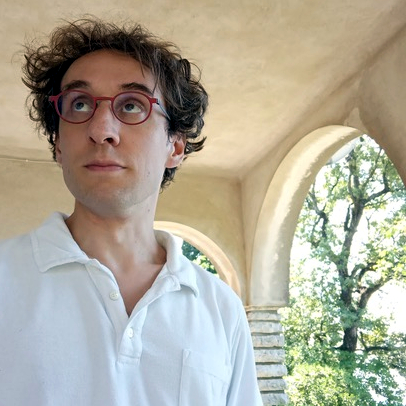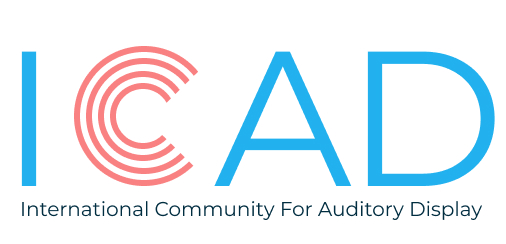Winner of the ICAD 2022 Best Paper Award
So, who are you?

I started as a musician, but my interest in music technology led me to study audio engineering in Graz, Austria. The local art scene opened a completely new world to me: I performed experimental computer music, created immersive media installations, and designed interactive sound and video projections for stage. While continuously balancing on the border between arts and engineering, I stumbled into the engineering side. My PhD on auditory augmentation helped me not lose contact to the arts. I am interested in the creation and perception of sound, from physical modeling to musical acoustics to psychoacoustics, the sounds of everyday objects and the interactions with the acoustic environment. I just finished running all projects, ready to start something new.
How did you end up working on Sonification and Auditory Displays?
My first conscious contact with sonification was through concerts in computer music that I visited as a student at the Institute of Electronic Music and Acoustics (IEM). And thereby also my own first sonifications were sound installations or live performances. Sonification, to me, was not a means for conveying information, but rather a starting point for creating interesting experiences; it should give the meaning to a sound, for example, to raise awareness towards a certain topic, but not convey a precise information encoded in the sound.
Having contributed to several artistic research projects at the IEM, I finally found my way into data sonification by working on an acoustic interface for tremor analysis and diagnosis. After my first contact with the sonification and auditory display community, I was already addicted.
What is the role of Sonification/Auditory Display in your research?
Sonification is one of the main driving forces behind my research. I want to project digital information into the physical environment. I don’t care about the data itself, as long as it is relevant to the users. However, I try to convey the information at the periphery of attention, without introducing additional sound events. I want to transmit more information with less displays. In fact, I dream of invisible visual displays and inaudible auditory displays.
What is the most challenging part in your work?
I had a hard time trying to create sonifications that are calm and unobtrusive, so that people might accept them sometime even at home. At best, they are not heard and do not interfere in a negative way with everyday activities, but at the same time introduce additional value through sound. I find it hard to keep a balance, for example, for demonstration purposes where the sound needs to be salient and obvious.
Most of my working time, however, I struggle with technical engineering problems, leaving too little space for dealing with the intended practical application, with the people that I design for, and the interactions between those two.
Anything special ICADders should know about you?
I am currently searching for a postdoc position or any other interesting job opportunity, not restricted to sonification, but anywhere in related fields. At the moment, I am willing to move almost everywhere in the world, preferably to a French-, English-, or German-speaking country.
I look forward to hearing from you, including if you want to collaborate, need technical advice, or just want to discuss a shared research topic.
What would you like to say to ICADders?
ICAD is the friendliest and most supportive research community I have ever met. Let me take this opportunity to sincerely thank you for having me! I admire the novel approaches and applications that emerge from the ICAD community every single year. Keep them coming! However, there are three things that make me angry*:
(1) 21st-century sonifications that are based on 20th-century General MIDI instruments.
(2) Data sonifications that sound absolutely fantastic but lack some kind of evaluation.
(3) Scientific sonifications that incorporate artistic decisions whenever science gets too complicated; and vice versa.
* Please don’t take this too seriously, I commit all these “crimes” regularly myself.
What is your favorite sonificaton/auditory display ever?
Although it has been mentioned in previous editions, and to be honest to myself: I absolutely love the soccer sonification by Richard Savery et al.: https://richardsavery.com/soccersonification
Any What is the study/tool/work in the field of auditory display you are most proud of?
The ICAD community just awarded my augmented table, which means I have to be proud of it. And to be honest, AltAR/table is the technically most complex and time-consuming sonification I have ever created. There is a short demo video here: https://phaidra.kug.ac.at/o:126460
Apart from the technical implementation published at ICAD [1], the conveyed information has been evaluated [2], and the inverse sonification problem has been solved [3].
[1] Weger et al. (2022). “AltAR/table: a platform for plausible auditory augmentation”. ICAD.
[2] Weger et al. (2022). “The information capacity of plausible auditory augmentations: percussion of rectangular plates”. ISon.
[3] Czuka et al. (2022). “Acoustic characterization of impacted rectangular plates”. ICA.
Any way to learn more about your work or reach out to you?
The currently most extensive collection of my research is found on ResearchGate: https://www.researchgate.net/profile/Marian-Weger
I used to document most of my work, including artistic projects, on my personal website; however, it became a bit outdated. I promise to update it as soon as possible: http://marianweger.com
Please do not hesitate to get in touch with me via email: mail@marianweger.com
